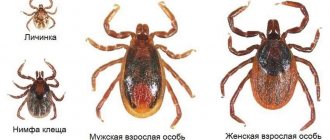Several types of mites can parasitize dogs: sarcoptoid mites (also known as scabies), Demodex Canis, which specializes exclusively on canids, as well as representatives of the ixodid family. It was the latter that got the name “dog tick”. But, despite the classification, not only pets, but also other animals and people become victims of the parasite.
Tick on a dog
Ticks on dogs are often found during the period of parasite activity (spring and summer, sometimes autumn). In warm weather, insects crawl out and wait on blades of grass, tree trunks and foliage of bushes until the intended victim passes by. Ticks determine its location by smell. Having determined the dog’s location, the parasites quickly move to its body and try to find vulnerable areas of the skin - soft and not protected by fur.
You can pick up ticks in the forest, in the park, even while walking along a small alley. These insects are poorly distributed in urban areas, but remain active in villages, holiday villages and large forest parks. Therefore, owners need to be careful not only when traveling out of town with their pets, but also when walking through nature reserves and parks.
The tick usually sits on the belly or is located behind the ears. It bites into the skin and begins to drink blood, plunging its proboscis. Tick salivary glands secrete small amounts of allergens to which some pets are sensitive. But the danger of the parasite lies not in this, but in the fact that it can be a carrier of deadly viruses and dangerous infections.
Therefore, it is so important to provide tick prevention in the summer, as well as constantly check the dog’s body for the presence of attached parasites.
Where does it live?
The dog tick is an arachnid. Latin name: Ixodes ricinus. This is a typical representative of the large Ixodid family. Also called European forest.
Parasites live in Europe, Asia, North Africa and North America. In Russia, they are widespread in the central zone, where they coexist with a related species - taiga ticks. However, warm winters are gradually expanding the distribution boundaries of Ixodes ricinus in northern latitudes.
Arachnids prefer damp areas where they can find a food source. Therefore, they are predominantly localized in mixed and deciduous forests, forest-steppes, meadows, lowlands, and near water bodies. But when there is a lack of food supply, they migrate to drier habitats. They comfortably tolerate ambient temperatures up to 30–35 °C.
Contrary to popular belief, dog ticks, like other representatives of ixods, do not live in trees and do not climb to great heights. They mainly live in grass, where it is more humid.
What does a tick look like on a dog?
The appearance of the parasite depends on how long the tick has been drinking blood from the dog. The hungry parasite is small in size, flat, with 8 legs. The head is dark, the body can be green, black or gray, as well as brown. Different shades of color are allowed. The size of the ixodid tick, the most dangerous external tick, in its initial form does not exceed a few millimeters. It is smaller than the pad of a finger. But as the abdomen fills with blood, the tick grows in size and can inflate up to 1–2 cm.
Usually, owners notice the parasite after it has attached itself. The insect can be confused with a wart or a voluminous mole, since when inflated it is round, and the head is not visible behind the large body. Redness and slight swelling appear at the site where the parasite attaches to the skin. If the tick has already fallen off, there will be a wound with a small bump. If it ruptures as a result of mechanical damage, the owner may notice a lump with a black dot in the middle. This is the head of an insect stuck in the epidermis.
There are about 48 thousand species of ticks. In addition to external ones, such as ixodidae, there are also intradermal and ear ones. However, they are not as common as ixodids, and are small in size, which is why they are inaccessible to the human eye.
Features of life
On average, the development of a dog tick from egg to adult lasts 2–3 years. During this period, it changes three owners. Under unfavorable conditions, the life cycle extends for 6 years.
With the onset of heat, pests leave their shelters, most often the peak of activity occurs in May-June, August-September. Females are oviparous. To lay eggs, the female must receive a portion of blood. The younger generation also needs nutrition to move to the next stage of development.
They prefer to hunt in the morning and evening, when the plants are wet with dew. Ticks do not jump or fly. They wait for their prey on the grass. Thanks to a well-developed sense of smell and thermoreceptors, a potential host can be sensed at a distance of 10–15 m.
Adults prefer large mammals:
- canids;
- horses;
- goats;
- cows, deer.
The larvae feed on smaller creatures: squirrels, voles. Nymphs choose large rodents, rabbits, foxes, birds, and wild boars. Having chosen a food source, the dog tick spends half an hour looking for a place to attach itself. The parasite's saliva has an anesthetic effect, so the victim does not feel anything. The female’s blood-sucking process can last from 1 to 5 days; young individuals feed for 1–3 days.
A dog tick can also bite a person if he does not feel the bloodsucker’s movements throughout the body.
What to do if your dog is bitten by a tick
If your dog is bitten by a tick, you should not hesitate to contact a veterinarian. It is not necessary to go to the clinic right away. The action depends on the type of tick that bit the pet.
The most common and dangerous parasite is the ixodid tick. It is its bites that cause encephalitis, piroplasmosis and other dangerous diseases. If the owner finds the tick already attached, he should try to remove it. If successful, the parasite is placed in a flask or container in case it needs to be analyzed. It is recommended to send the parasite for testing in the following situations:
- an ixodid tick bit a pet in an area where many cases of attacks by encephalitis parasites have been reported;
- Deviations were noticed in the dog’s behavior that may signal the development of the disease.
In both cases, it is important not only to deliver the material to a specialist for analysis, but also to have your pet examined at a veterinary clinic. The specialist will give several injections that will reduce the risk of developing fever and viruses.
You need to monitor your dog after a bite not for several hours, but for several weeks, since some viral pathologies have a long incubation period. At the first signs of disease development, you should contact your veterinarian.
To accurately determine whether you need to visit a doctor, it is recommended to call your veterinarian immediately after discovering the parasite. A consultation will help you choose the best method for tick removal.
Tick-borne spring-summer encephalitis
Tick-borne spring-summer encephalitis is an acute viral disease that is characterized by a sudden and rapid onset of the disease, fever and severe damage to the central nervous system. The disease is a natural focal disease, and is widespread in the north of Russia, the Far East and the Central European part. Natural reservoirs are wild animals (often rodents), and carriers are ticks of the genus Ixodes. In particular, the dog tick is the main carrier of the pathogen from wild animals to humans.
As a rule, even at the larval or nymph stage, the arachnid becomes infected with the virus during blood sucking. The tick transmits the causative agent of tick-borne encephalitis to all subsequent hosts, and the longer a dog tick feeds, the higher the likelihood of infection with the subsequent development of the disease.
On a note
Tick-borne encephalitis is also transmitted by the taiga tick (Ixodes persulcatus). However, its habitat is shifted to the north, so the northern and Far Eastern regions suffer from it. Many scientists believe that this encephalitis has a different form, which is more pathogenic than that carried in the central part of the country by Ixodes ricinus.
Signs of a bite
The main sign of parasite damage is a lump after a tick bite on a dog. It forms around the wound and can reach up to 1–2 cm in diameter, depending on the pet’s tendency to allergic reactions. The swelling is usually reddish and, when pressed, causes pain in the pet.
The lump does not always occur. Sometimes it simply remains hidden under the fur. There are other signs by which you can understand that the dog is in danger:
- the pet scratches a certain area (behind the ears, groin, abdomen);
- the dog has lost activity and appetite, mostly lies down;
- the dog reacts aggressively to touch, especially in a certain place;
- heat is noticeable when touched;
- the nose became dry and hot;
- The dog is constantly breathing with its tongue hanging out, although it has not been subjected to either increased physical activity or exposure to heat.
If all of the above signs occur, the dog should be examined. If the pet shows aggression (this is a normal defensive reaction for a wounded or sick animal), a muzzle is put on. Holding the dog by the collar, you need to check the main places where the parasite usually attaches itself. This is the area behind the ears, neck, especially the strip under the collar, groin, back of the paws, tail, withers. If the parasite was not found in these places, you will have to examine the dog's entire body, since sometimes the tick can infect other areas.
After a parasite bite, various nonspecific symptoms may develop. Among them:
- increase in body temperature (from 38–39 to 40–42);
- increased pet fatigue;
- refusal of food and water;
- aggression;
- problems with coordination;
- drowsiness;
- swelling of the bite area and the development of inflammation with the release of pus or redness.
These signs indicate the need to take your pet to the veterinarian.
The best treatment method is an antidote for a tick bite for a dog. The antidote is selected depending on the disease that the tick suffered. There are also universal means. Thus, some German companies produce special tablets for oral use that provide protection against encephalitis in dogs for a whole month, even in the event of a bite. However, such remedies should be used before the bite: for example, when the family is going to go to the country or relax in nature.
After a tick infestation, injectable drugs are used for intravenous administration. They provide the fastest possible action and allow you to stop the development of diseases at an early stage.
Scottish encephalitis
Scottish encephalitis is an infectious disease that mainly affects sheep, less commonly horses and pigs. It is rarely transmitted to humans - mainly if he visits agricultural pastures and is attacked by infected parasites.
Symptoms of the disease are typical for encephalitis: muscle weakness, drowsiness, headaches, fever. The disease occurs in two phases with exposure for about a week. However, unlike ordinary spring-summer encephalitis, treatment of Scottish encephalitis in most cases ends with a complete recovery of the person.
What can you do at home?
If your dog is bitten by a tick, be sure to find out the symptoms and treatment methods at home. An uninformed owner may take actions that will harm the pet.
So, you cannot do the following:
- Expand the wound to remove the proboscis or head of the tick.
- Use oil or alcohol to suffocate the parasite. The alcohol composition is suitable for disinfection after the insect has been removed.
- Allow the dog to scratch the wound. It is best to wear a collar. If the pet tries to lick the bite site (when located on the paw), a muzzle is put on.
- Leave the head of the tick in the dog's body. This will lead, at best, to suppuration of the wound, and at worst, to encephalitis.
- Remove the tick by pressing on its body. If you press on the abdomen of the parasite, it will begin to release saliva containing pathogens into the dog’s blood with redoubled force.
If you have access to a veterinary clinic, you should visit it as soon as possible. But even at home, you can take some actions that will reduce the risk of developing pathologies.
It is necessary to remove the parasite using one of the common methods. Fatty substances should not be used for suffocation. You can use thread, tweezers, or a special tool to pull out the tick. It is not advisable to use a needle. If it is not sterile even after heating and treating with alcohol, an infection will enter the blood. A rusty instrument will lead to sepsis.
It is better for dog owners to purchase tick removal tools in advance. They can be purchased at a human pharmacy. Special adaptations for animals are more difficult to find. You can try looking for them in online stores, but there is not much difference between “human” and veterinary forceps for removing the parasite. If you have these forceps in your arsenal, you need to grab the parasite right at the head and carefully pull it out. The device is equipped with a special flask. The insect is placed there so that it can be easily transported to a veterinary clinic for analysis.
It is equally convenient to remove a tick using tweezers. It should be small, manicured, without signs of rust. The tick is grabbed close to the skin and pulled out of the dog's body using twisting movements. Do not sharply pull or grab the parasite by the lower or middle part of the body.
The last method is to remove it with a thread. It is not suitable for eliminating small ticks. The thread is draped over the body of the tick and tightened around the head. Using slow movements, you need to pull the parasite out of the body. The tick must be held perpendicular to the skin.
If the parasite is too small or has burrowed deep into the skin, none of the above methods will work. Then the wound is treated with iodine, and the owner goes to the clinic to have the parasite removed with the help of a veterinarian. The specialist will make a small incision or use miniature tweezers.
Advice: if the tick is small and hard to see, and also if it is buried deep into the skin, you need to remove the dog’s hair (you can carefully shave it without touching the wound) and rub the affected area with damp gauze. The dark (or gray) body of the tick will immediately become noticeable.
Q fever
Q fever is an acute natural focal disease caused by Burnet's rickettsia. The disease is characterized by an acute chronic course and primary severe damage to the respiratory tract, causing first bronchitis and then pneumonia.
The photo below shows the bacteria Coxiella burnetii at high magnification:
Foci of the disease exist both in the wild (wild artiodactyls, rodents) and can be anthropourgic (the source is farm animals: cattle, sheep, pigs, horses, poultry).
The carriers are ixodid ticks, in particular the dog tick. The infected parasite, feeding on a new host, defecates to free the intestines for new portions of blood. Rickettsia also comes out with excrement. Through a wound in the skin, pathogens enter the human or animal body - this is how infection occurs.
Possible consequences of a bite
The consequences of a tick bite on a dog are varied and dangerous. The biggest fear of dog owners is encephalitis. There is debate as to whether it is transmitted to dogs. Some experts give a positive answer. This infection affects the pet’s brain in a matter of hours and can lead to death in 1–2 days.
In addition to encephalitis, there are other infections and viruses. Amid the fear of viral diseases, dog owners forget that another consequence of a bite is no less dangerous - the development of suppuration and inflammation. If you do not remove the head and proboscis of the tick or forget about disinfection measures, the lump may swell and begin to secrete pus.
Inflammation can lead to weakened pet immunity, loss of activity, appetite, and general exhaustion. If it develops to a serious size, necrosis of tissue and some muscles close to the skin is possible.
Sometimes dogs themselves lead to the development of infection. They scratch the bite site and bring dirt into it. In this way, dermatitis, lichen, fungal skin infections and even blood poisoning can begin. If your pet constantly scratches the sore, the skin around which is often itchy, non-healing ulcers on the skin are likely to develop. And against the background of weakened immunity due to the development of infection, pets begin to develop colds, conjunctivitis, and fever.
Ticks can be intermediate carriers of helminth eggs. Once in the dog’s body, these parasites remain in it forever (in the absence of treatment), causing digestive disorders, exhaustion, and damage to the liver and biliary tract.
Diseases transmitted through ticks to dogs are destructive to health, sometimes fatal. Experts note the following most dangerous infections that develop as a result of the release of viruses and bacteria from the salivary glands of the parasite:
- Piroplasmosis. The disease develops against the background of the activity of single-celled bacteria. Microorganisms lead to the breakdown of red blood cells in the blood, which ends in death due to failure of the lungs and heart.
- Borreliosis. Leads to joint destruction, arthritis, and central nervous system dysfunction. The disease is transmitted to humans through blood (for example, through a pet bite). Here is written in detail about the Borreliosis mite.
- Bartonellosis. The disease leads to exhaustion of the body, followed by weight loss, and disruption of the cardiovascular system. Characteristic is the development of anemia, which reduces the pet’s immunity and activity. An inflammatory process in the joint area, accompanied by a feverish state, is possible.
- Encephalitis. Against the background of this disease, fever develops and disturbances in the functioning of the central nervous system appear. In the terminal stage, the pet's brain fails.
How to treat a tick bite on a dog to reduce the likelihood of developing diseases? It is necessary to wash the wound with soapy water and then apply a 5% iodine solution. If you suspect the development of pathology, then you need to go to the veterinarian.
Medical significance
The medical significance of the dog tick is determined, first of all, by the fact that this parasite is a carrier and reservoir of pathogens of dangerous infections: choriomeningitis, Scottish encephalitis, eastern encephalomyelitis, St. Louis encephalitis, tick-borne viral encephalitis, Langat, Kemerovo, Kumlinge, West Nile viruses, Crimean hemorrhagic fever.
It has also been established that the dog tick is a carrier of pathogens of bacterial infections: tularemia, listeriosis, erysipeloid and rickettsial diseases: Q fever, Rocky Mountain spotted fever, paroxysmal rickettsiosis, tick-borne typhus of Central Asia. It is for this reason that experts have repeatedly attempted to combat the populations of this blood-sucking parasite.
The most common and frequently occurring in humans and domestic animals are:
- tick-borne spring-summer encephalitis;
- Scottish encephalitis;
- Q fever;
- tick-borne borreliosis (Lyme disease).
Can a tick fall off a dog on its own?
What does a tick do after it drinks blood? If we are talking about an ixodid parasite, then the insect can actually go away on its own. However, if your dog is affected by scabies mites, you should contact your veterinarian. Otherwise, they will seriously damage the ear canals or skin.
Despite the fact that the parasite falls off on its own over time, you shouldn’t wait for it. The dangerous organism must be removed immediately. The tick can stay on the pet's body for 24 hours. During this time, the risk of infection reaches critical levels. And when an insect gets drunk, it greatly increases in size and can fall under its own weight. In this case, the proboscis will remain in the body. If the insect is a carrier of a virus or infection, then the proboscis remaining in the body will lead to the development of pathology. Even the proboscis of a “pure” ixodid tick can lead to inflammation and suppuration.
A dead tick on a dog does not fall off. Its removal without human intervention can only occur if the tissue begins to regenerate and new connective cells displace the foreign object. However, ticks that have settled too deeply can remain in the body and simply become overgrown. The abdomen and main part of the body will fall off, and the head and proboscis will grow in. After this, it will be very difficult to remove the foreign object: the veterinarian will have to cut the pet’s skin, which will cause him unnecessary discomfort.
Reproduction
Mating of dog ticks occurs on the body of the victim. Males feed for a short time, 20–30 minutes, and after fertilization of the female, they soon die. The satiated female falls to the ground and after a few days begins to lay eggs in moist soil, foliage, and forest litter. Fertility amounts to several thousand. But most of the embryos die.
The development of the eggs lasts about 3 weeks, after which small larvae up to 1 mm in length appear. Juveniles have only 3 pairs of walking legs. The larval stage lasts from 1 to 6 weeks. After feeding, the larvae molt and turn into nymphs, which outwardly look like adult ticks, but are not yet capable of reproduction. To transition to the adult stage, nymphs also need nutrition.











